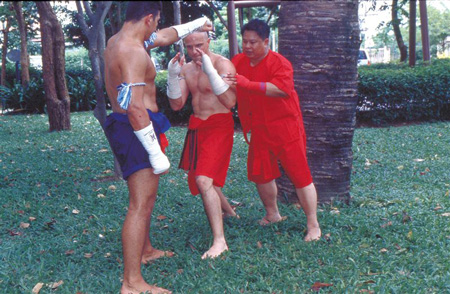Technical progression in Muay Boran training
by Marco De Cesaris

According to the old Thai
masters, Muay Thai is an art of combat that makes the adept effective
in confrontations with one or more adversaries, utilizing the natural
weapons of the body from the head to the feet; in combat, one must know
how to use the arms to strike, grab, and fight, and each part of the
body is prepared in the best way as a “tool” to attack and
defend oneself from aggressions of any kind: frontal, from the side,
and from behind. The serious student has to learn what the weak points
of the human body are in order to learn to reach them with his attacks
and has to condition the strong parts of his own body in order to use
them as defensive shields and as offensive blades, maces, and sticks.
For that, the study of the Siamese art is derived from the “9
weapons”, that is to say that Muay Thai teaches one to utilize,
with scientific efficiency, the head, hands, elbows, knees, and legs
(the Chern Muay techniques). Furthermore, the true master will also
teach his students to utilize other parts of the body, though in a secondary
way: forearms, hips, shoulders, and all the parts of the foot will become
real weapons of destruction through correct and assiduous practice.
Of course, learning the use of these natural weapons (principle and
secondary) demands a long period of intense and continuous practice
during which it will be essential to combine the correct method of use
of the instruments with the most efficient system of application of
the ancestral principles of combat, as much for attack as for, and especially,
defending oneself. In fact, all the traditional Muay Thai schools applied
the universal principle of surviving the attacks, remaining physically
unharmed; to cite a famous Latin motto: “Primum vivere!”
If they attack you with punches, kicks, elbows, knees or grips, the
first objective of the practitioner has to be to defend himself effectively
with movements, blocks, feints, or counterattacks, in order to later
respond with one of the natural weapons definitively (Kon Kee).
As we can imagine, the first learning steps of the discipline were not
the same in the various traditional Siamese schools, contrary to what
occurs in modern times where the tendency is toward official authorization
of the technical progressions in order to quickly create a professional
for the ring, people ready to fight, and in this way keeping the ticket
sales that come from the professional fights profitable.
In fact, each style and within the various stylistic currents, each
famous master taught the techniques in very different ways.
For example, the boxers of the Muay Chaiya style put great emphasis
on defensive work and consequently the neophyte, right from the first
months of practice, studied evasive movements in detail; the side-steps,
the fast guard changes and the movements in triangle constituted the
base work of a neophyte of this style for a long initial period. Later,
came the concept of counterattacking from the fist movements and then
on to the elbows, and step by step to the other weapons.
On the other hand, in Muay Korat, the initiation of the neophyte was
focused on learning a correct guard position and on the study of the
rhythm of the steps with offensive and defensive objectives; the movements
that are still executed in the Ram Muay (warrior dances) of this style
were used from the beginning in order to teach the student to relate
to the surrounding space, reducing the possibilities of the adversary’s
maneuvering and at the same time, defending one’s own vital area.
In order to do that, the Korat boxer, as well as the practitioners of
the other styles, trained long hours in order to refine their combat
posture, coordinating the cover work put into effect by the arms and
legs with the movements always put into effect with rhythm changes to
surprise the adversary. As far as the rhythm of the movements of a traditional
fight goes, the big difference with respect to how a modern Thai boxer
moves must be highlighted; in past times, the fights were done without
time limits, so the boxers had a slower rhythm, with sinuous and harmonious
movements, in order to later explode suddenly with very fast actions
seeking a fast KO. However, not having the results of the attack certain,
in the case of a good defense on the part of the adversary, the fighter
went back to a slower rhythm to conserve his precious energy, necessary
for the prolongation of the confrontation.
In any case, at all times, a correct guard position was necessary in
order to assure effective defensive techniques and quick counterattacks:
for that, the characteristic steps of the various traditional styles
were repeated many times, combining them with guard positions that,
if compared to a modern Thai boxer, can seem a little anomalous. In
reality, those techniques deserve all our attention; when the combat
was a fight for survival and preparation for war (though governed by
established “gentlemanly” norms of respect for the adversary)
and not a sportive confrontation, every detail of what the ancestral
warriors practiced and applied in combat was the fruit of the experience
of generations of fighters. Every action was studied to perfection,
not for aesthetic reasons, but because it could make the difference
not only between victory and defeat, but also between life and death.